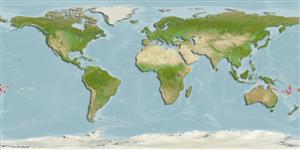Teleostei (teleosts) >
Ophidiiformes (Cusk eels) >
Dinematichthyidae (Viviparous brotula)
Etymology: Diancistrus: Greek, di = two + Greek, agkistron = hook (Ref. 45335); tongaensis: Named for Tonga where the majority of the specimens were taken.
More on authors: Schwarzhans, Møller & Nielsen.
Environment: milieu / climate zone / depth range / distribution range
Ecology
Marine; reef-associated; depth range 1 - 10 m (Ref. 57884). Tropical
Central Pacific: New Caledonia to southern Vanuatu, Fiji, Tonga and Samoa; tentatively Santa Cruz Islands (Vanikolo), Vanuatu (Banks Islands), Phoenix Islands (Kiribati), Wallis Island and Tahiti.
Size / Weight / Age
Maturity: Lm ? range ? - ? cm
Max length : 4.5 cm SL male/unsexed; (Ref. 57884); 5.8 cm SL (female)
Short description
Identification keys | Morphology | Morphometrics
Dorsal soft rays (total): 71 - 80; Anal soft rays: 57 - 66; Vertebrae: 39 - 42. This species is characterized by the following: vertebrae 11+(28)29-31=(39) 40-42, dorsal fin rays 71-80, anal fin rays 57-66; small eyes (1.3-2.3% SL); outer pseudoclasper with large ear-lobe extension, ventrally opening; inner pseudoclasper free from outer pseudoclasper, with supporter, forming a broad, distally expanded, not inclined flap, with short thorn; narrow scale patch on cheek, no scales on operculum; head profile slender; otolith length to height ratio 1.9-2.0 (Ref. 57884).
Life cycle and mating behavior
Maturity | Reproduction | Spawning | Eggs | Fecundity | Larvae
Schwarzhans, W., P.R. Møller and J.G. Nielsen, 2005. Review of the Dinematichthyini (Teleostei, Bythitidae) of the Indo-West-Pacific. Part I. Diancistrus and two new genera with 26 new species. The Beagle, Records of the Museum and Art Galleries of the Northern Territory 21:73-163. (Ref. 57884)
IUCN Red List Status (Ref. 130435: Version 2024-2)
Threat to humans
Harmless
Human uses
Tools
Special reports
Download XML
Internet sources
Estimates based on models
Preferred temperature (Ref.
123201): 24.7 - 29.4, mean 27.7 °C (based on 552 cells).
Phylogenetic diversity index (Ref.
82804): PD
50 = 0.5000 [Uniqueness, from 0.5 = low to 2.0 = high].
Bayesian length-weight: a=0.00389 (0.00180 - 0.00842), b=3.12 (2.94 - 3.30), in cm total length, based on all LWR estimates for this body shape (Ref.
93245).
Trophic level (Ref.
69278): 3.3 ±0.5 se; based on size and trophs of closest relatives
Fishing Vulnerability (Ref.
59153): Low vulnerability (10 of 100).
